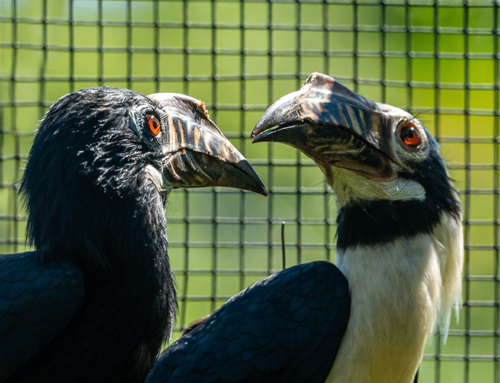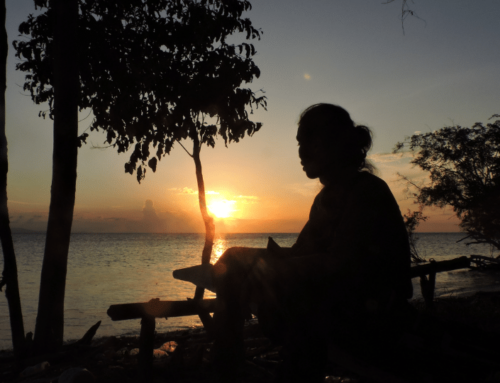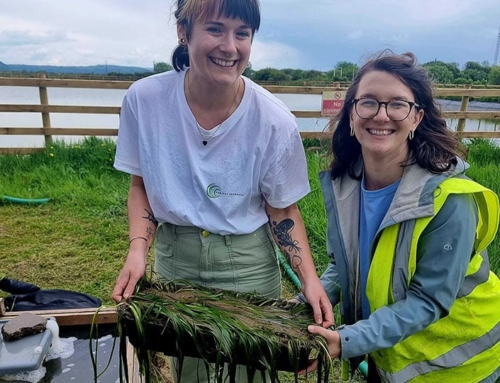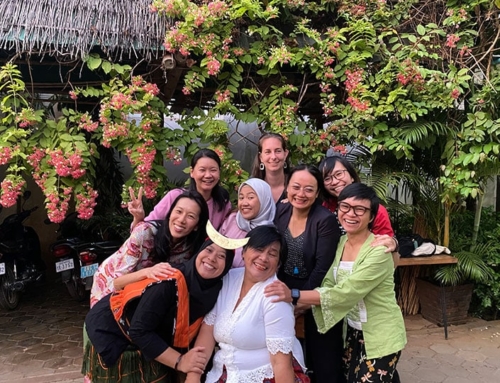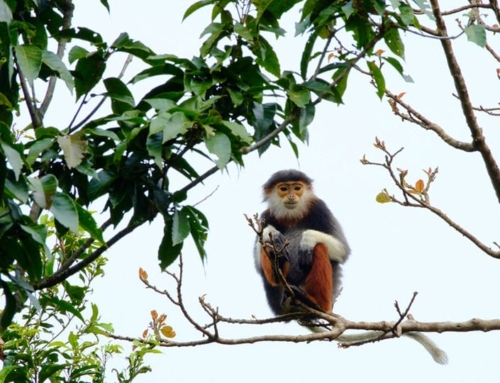The protection of endangered plants is often overlooked in the world of conservation. But not only is the conservation of plant species vital for overall ecosystem survival, there are also specific threats facing plant species which need to be tackled and protecting them is a far more fascinating endeavour than you might expect. Anna Heath describes the evolutionary tricks which make orchids so striking and how the orchid trade is threatening the future of a particularly rare group: the slipper orchids.
When you think of an endangered species in Southeast Asia, what do you think of? For most people, this is probably an orangutan or an elephant, perhaps a pangolin.
The vast majority of people would not think of an orchid, even though there are 124 species of orchid in South and Southeast Asia currently listed as Endangered or Critically Endangered on the International Union for Conservation of Nature (IUCN) Red List of Threatened Species.
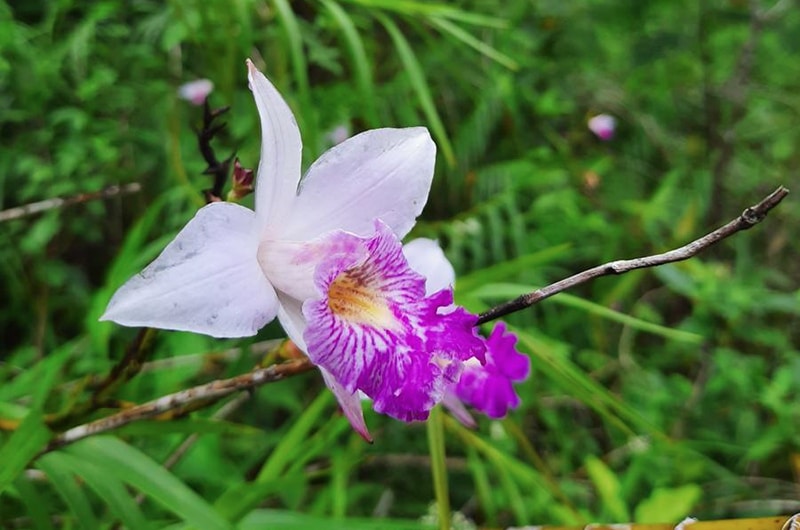
This beautiful bamboo orchid often grows in the same place as the much rarer Paphiopedilum agusii orchid, so perhaps this noticeable species can be used as an indicator to identify the more elusive and less vibrant species. Image © Destario Metusala
Orchids: A diversity of trickery
Orchids are the world’s most diverse group of flowering plants, and it is estimated there are over 27,000 species of orchids. But did you know that some species use trickery to entice pollinators?
Unlike most other flowering plants, which produce nectar to lure pollinators to them, many orchids instead rely on deception to attract their pollinators. The bee orchid, for example, takes advantage of male bees looking for a mate. Unwitting male bees scouting for females are enticed by a female bee scent and a large petal that has evolved to resemble a female of a specific species of bee sitting on a flower (it is even hairy!). While the male bee believes he is having a successful encounter with a female bee, the orchid sneakily dumps pollen onto his back, which is transferred to another bee orchid if he is foolish enough to be tricked twice.
Another group of orchids known as slipper orchids has favoured food deception over sexual deception. They rely on deceit combined with a clever bit of structural design to attract their pollinators of choice – hoverflies. Many species in this group have spots resembling aphids, which is a specific lure for pregnant hoverflies that like to lay their eggs in aphid colonies. Once the hoverflies have been lured in, they fall into a slipper-like pouch under the fake aphids. From here, they are only able to escape via a carefully structured tunnel that forces them to rub their bodies along specific parts of the orchid – the parts which distribute and collect pollen.
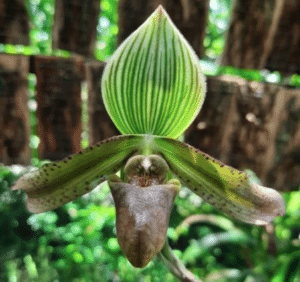
The Java slipper orchid Paphiopedilum javanicum. Image © Orchid Specialist Group
These intricate relationships (fraudulent as they are) with their pollinators add to why orchids are so vulnerable. If an orchid is reliant on just one species of insect to pollinate it, anything that affects the population of that insect will also impact the orchid.
This level of specialisation is also what leads to the high variety of beautiful flowers associated with orchids. This is what makes them so attractive to collectors for the plant trade – a key driver of their decline, particularly in Southeast Asia.
Unfortunately, the slipper orchids mentioned above are one of the groups that is in great demand and are amongst the most threatened wild orchids on Earth. IUCN Red List assessments of this group show that most of them are threatened with extinction.
Filling in knowledge gaps
Concerned by the plight of Southeast Asian slipper orchids, and as part of its mission is to support conservation for overlooked and underfunded species, Synchronicity Earth supported the IUCN Orchid Specialist Group to carry out a baseline study to find out more about the level of threat faced by slipper orchids.
The study focused on the orchid trade and existing conservation work for slipper orchids in Indonesia, home to a rich diversity of this group, the majority of which are threatened with extinction. Through this project, Synchronicity Earth had the chance to work with Dr Destario ‘Rio’ Metusala, a passionate young botanist based at the Research Center for Plant Conservation and Botanic Gardens, Indonesian Institute of Sciences (LIPI).
While the work faced serious delays due to COVID-19 lockdowns in Indonesia over the past two years, Rio was able to quickly take advantage of a lifting of restrictions last year to carry out some groundbreaking work for orchid conservation in Southeast Asia.
Homing in on a new species
One main focus of the work last year was to gain better information on a newly discovered species of slipper orchid, Paphiopedilum agusii (it is so new that it does not have a common name yet), that was officially described for the first time in 2017.
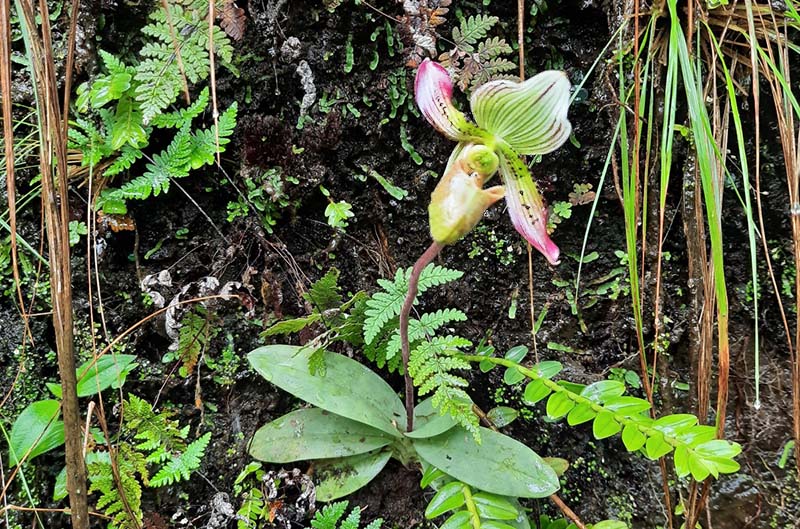
The newly described slipper orchid species Paphiopedilum agusii. Image © Destario Metusala
It is common for individual orchid species to only be found in one small area because as a species they tend to be extremely picky. Alongside the associations they develop with specific pollinators, they are also known to have links with fungi that support their germination process. Orchids also rarely grow in the soil and often rely on a specific host plant that they will grow on exclusively. Because of this, any one species of orchid can only grow where the right pollinator, fungus and/or plant is present.
Paphiopedilum agusii is no exception to this trait in orchids, as so far it is only found in a narrow area in Java, Indonesia. As with any species that is only found in one small area, this makes them incredibly vulnerable.
Very little information was available about this species, including information about its habitat requirements, threats, and the collecting patterns affecting it. Rio and his small team set out to a district of Java which is the only known site for this species.
The first point of call was to speak to local communities, to find out more about their views and activities, and to learn from their experiences in finding and cultivating this orchid. The team learned that this species could only be found on the outskirts of a local pine tree plantation. Here it seemed that the planting of these non-native trees, as well as high levels of collection from the wild, had pushed the remaining population out to the most extreme habitat, including dangerously steep slopes and cliff edges.
To his horror, Rio was told about a local community member who had lost their life on one of these cliffs, trying to collect an orchid. This story brought into stark focus the extreme lengths that people will go to access this species, as such an important part of their livelihoods. Based on their findings, the team predicted that the remaining living population of this rare orchid will continue to shift to the most hard-to-reach areas in this habitat.
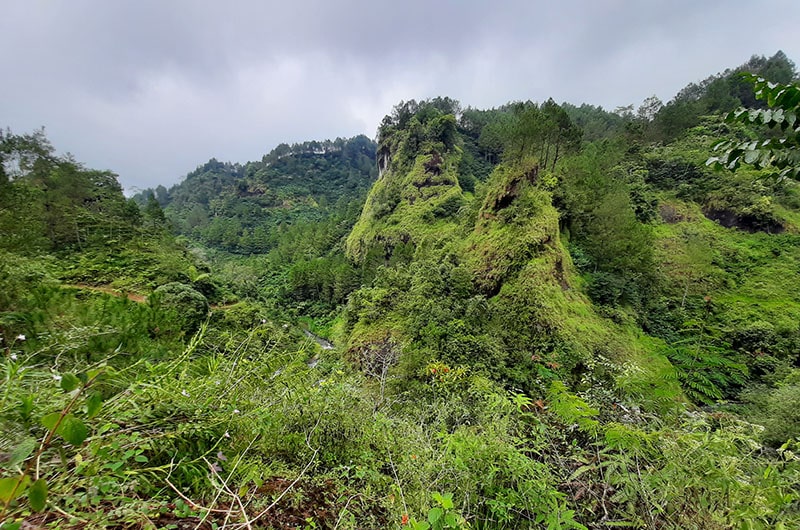
The natural habitat of Paphiopedilum agusii which usually grows on the sides of cliffs. Image © Destario Metusala
A sustainable future?
However, the good news is that Rio and his team found hundreds of surviving small seedlings of this orchid, although only a handful of mature-sized plants were left in the habitat. The presence of many seedlings may be a good sign for the regeneration of this species in the future… if the main threats can be controlled.
Rio and his team spoke in-depth to local communities about their work and the challenges they face. One of the local people took Rio to his modest ‘shade house’ (similar to a greenhouse, except rather than keeping the sun in these are built to keep the sun out), which contained hundreds of individuals of this slipper orchid that he had cultivated himself. Unfortunately, many of the plants were suffering from rot.
A key outcome of these discussions was that the local communities showed interest in learning how to grow orchids in captivity and reduce the collection from the wild. Involving local communities in community development programs such as cultivation training may become an effective solution for the sustainable trade of this plant without affecting local livelihoods.
During this project, Rio and his team also had a chance to visit some habitats of four orchid species in East Java (Java Island) and Aceh (the northernmost part of Sumatra Island). These included the shiny green leaf paphiopedilum and Liem’s paphiopedilum. The team concluded that all existing wild populations of these slipper orchids faced similar threats – habitat degradation and over-collecting.
Speaking to collectors about the orchid trade
Another key group that Rio wanted to speak to and engage with was Indonesian orchid collectors, to find out what drives their hobby and which species they have in their collections. Rio and his team carried out interviews with 70 hobbyist collectors from five different provinces and three different major islands in Indonesia (Sumatra, Java, and Papua).
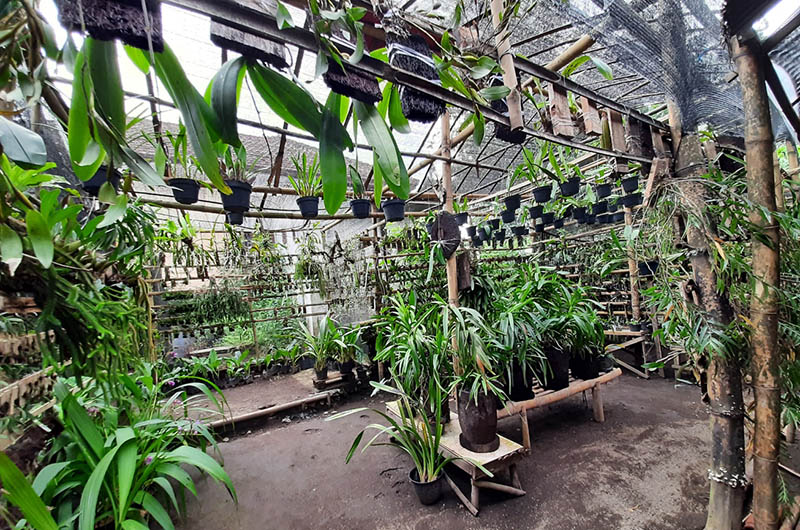
Orchids are grown in shade houses where, unlike greenhouses, the plants are deliberately grown out of sunshine. Image © Orchid Specialist Group
Through these interviews, the team was able to inventory more than 40 species of slipper orchids held in these private collections. Of these, almost two-thirds are listed on the IUCN Red List as Critically Endangered or Endangered species. These collections also included several species that have not yet been assessed on the IUCN Red List, including Paphiopedilum agusii mentioned above.
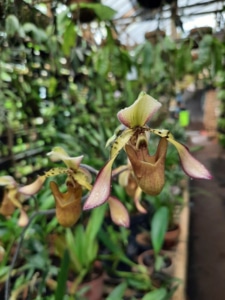
P. richardianum, one of the unique species in the highlands of Sulawesi which is being grown in a shade house by a trader as the species is becoming rare in the market. Image © Orchid Specialist Group
An exciting outcome of this work was that the collectors agreed to collaborate and allow their collections to be used for research and conservation purposes, which will mean a lot more can be learned about these highly threatened species.
These interviews provided important new information on trade patterns; the team found that when a new species is discovered this normally leads to an increase in demand for this species, but this usually significantly decreases after about two years.
The team also found that the COVID-19 pandemic reduced the demand for slipper orchids but increased the demand for other ornamental foliage plants. Therefore, many orchid collectors and traders have switched to non-orchid commodities.
Another interesting finding was that collectors are showing an acceptance or even preference for orchids that are grown in greenhouses, as they are more adaptive and grow faster than wild-collected plants. This is a positive indicator of a behaviour shift, compared to 10 years ago, when most collectors usually preferred wild-collected plants due to their authenticity. This is a very encouraging finding, especially when considering the interest from local communities to learn more about these propagation techniques.
Planning for the future
Rio is now working with his colleagues from the IUCN Orchid Specialist Group to pull together all of the new information gathered during this project, and to develop an effective plan of action to move forward with slipper orchid conservation in Indonesia.
By taking a highly collaborative and respectful approach to this work, and engaging with local communities, collectors, and academics alike as equals, Rio and his team have built a diverse network of people that are now eager to engage in orchid conservation.

